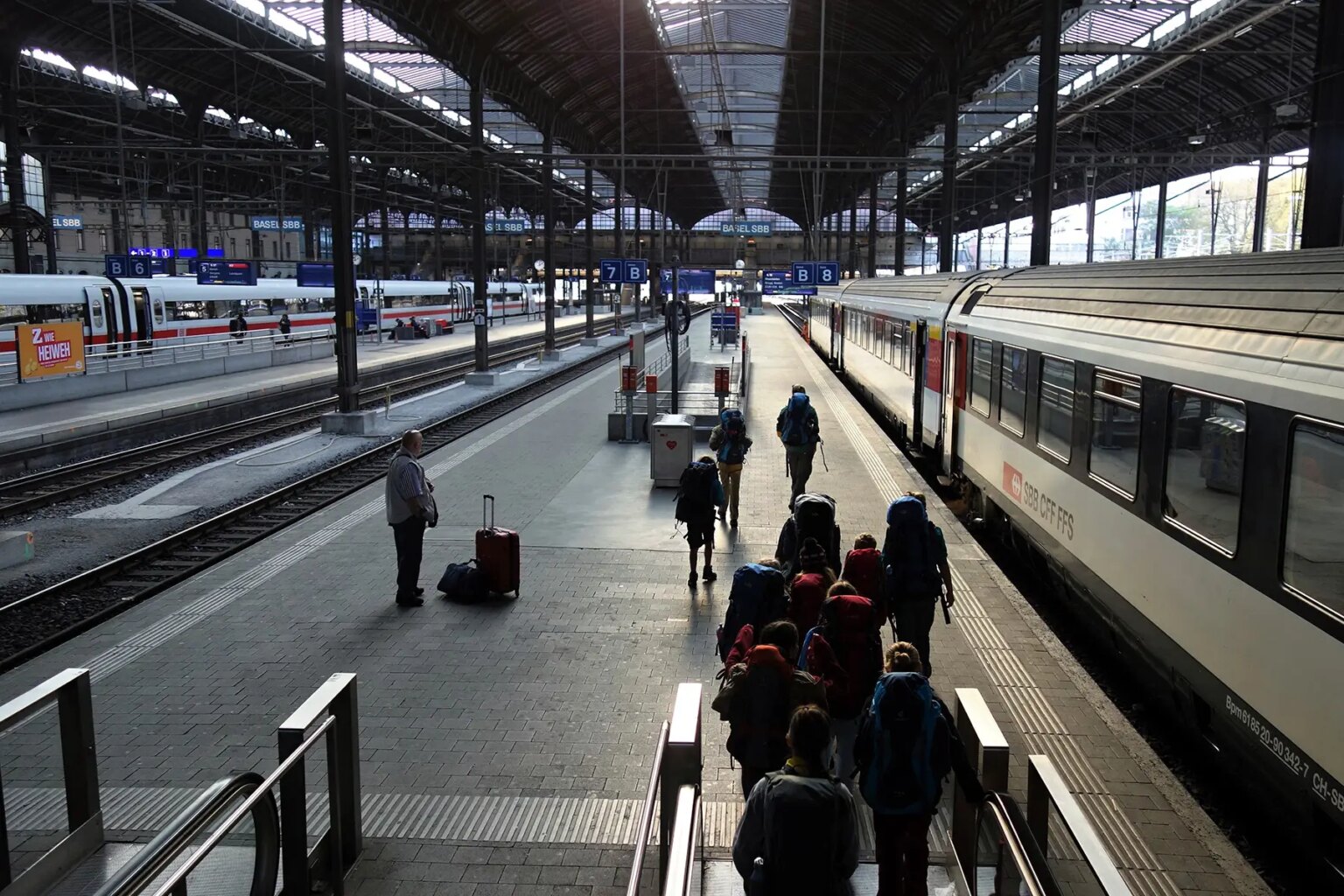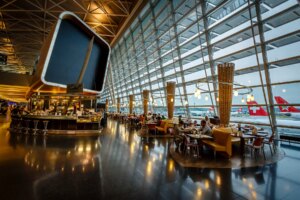Who needs a car in Switzerland when you have access to one of the best public transportation systems in the world? With effective transport planning and user-friendly services, it’s easy to plan a journey in the gateway to the Alps.
Hop on board and learn more about Switzerland’s envy-inducing public transportation system, including topics such as:
- Public transportation in Switzerland
- Swiss public transportation apps
- Trains in Switzerland
- Bus transportation in Switzerland
- Taxis and ride-sharing services in Switzerland
- Long-distance coaches in Switzerland
- Airports in Switzerland
- Other methods of public transportation in Switzerland
- Public transportation subscriptions in Switzerland
- How disability-accessible is public transportation in Switzerland?
- How environmentally friendly is public transportation in Switzerland?
- Fines and public transportation complaints in Switzerland
- Useful resources
Omio
Want to fly away from it all? Or maybe you're looking for a family adventure by train? Wherever you're going, Omio can help you find the best deals for your journey. This one-stop shop lets you compare a range of transport modes, explore new destinations, and buy tickets at the touch of a button. Wherever adventure takes you, get there with Omio.
Public transportation in Switzerland
Few countries are more enjoyable to traverse by public transportation than Switzerland is. With incredibly efficient services that sync with one another almost seamlessly, you’ll find that taking the train or the bus is often the option with the least hassle. You won’t be alone, either; the average Swiss resident takes the train about 70 times per year, more than any other European country.
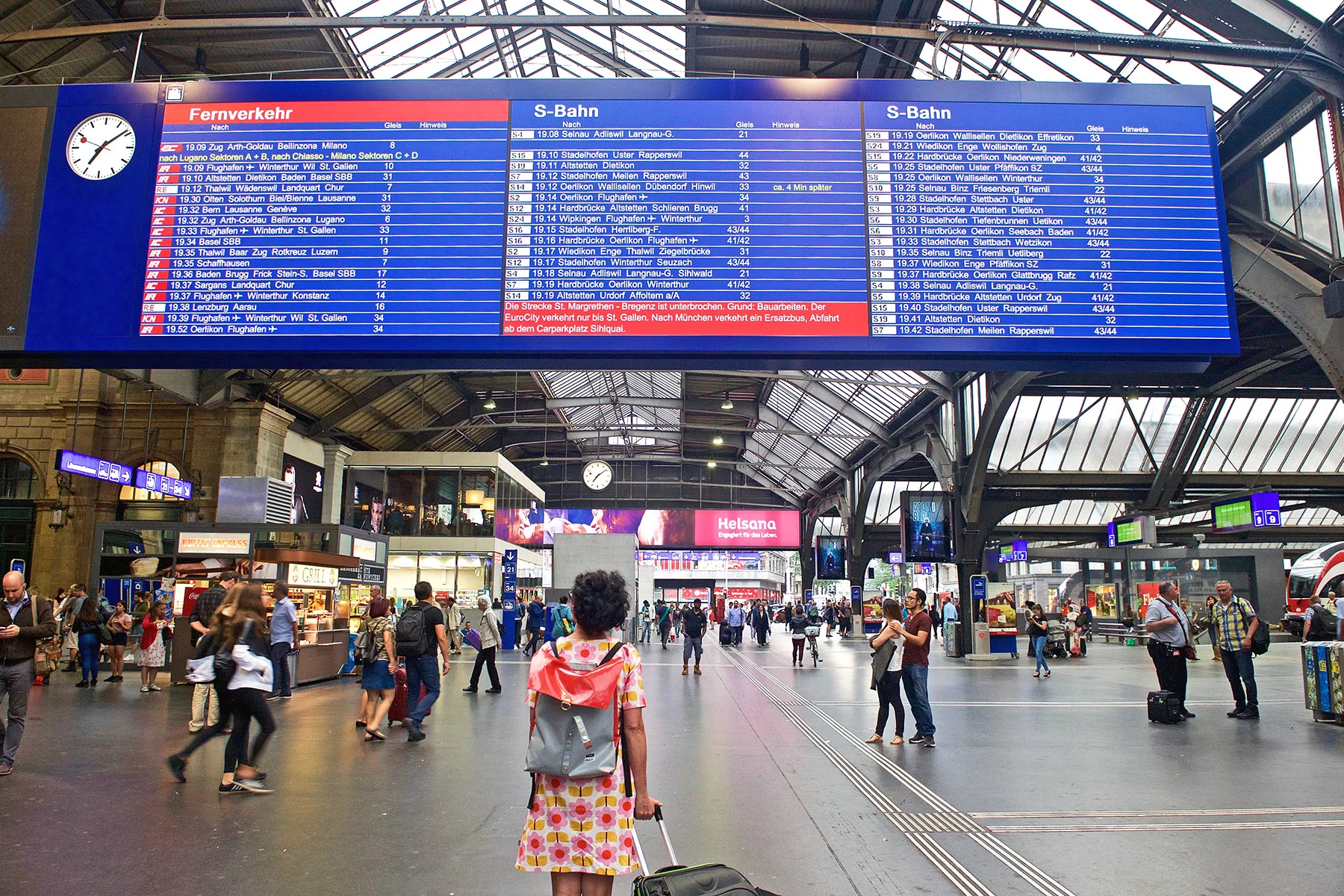
The Federal Office of Transport (FOT) oversees all public transportation within Switzerland. FOT ensures that all the companies carrying passengers are safe and accessible for disabled travelers. They’re also responsible for Switzerland’s railway expansion plans, improving transportation connectivity with neighboring countries, and Switzerland’s ambitious transportation energy strategy.
Public transportation in Switzerland takes many forms, including trains, buses, trams, boats, funiculars, and even cable cars. Most transportation modes are operated at a local or regional level, though; the fare rules in the next city over could be completely different from your own. Despite any regional variations, Switzerland is an exemplary case of how public transportation should work.
Swiss public transportation apps
SBB Mobile is the official app of the Swiss Federal Railways. The app allows users to search for itineraries, book tickets, and add public transportation subscription and discount cards for accurate pricing. The app also has a handy feature called EasyRide, which lets users check in and out of public transportation and charges the ticket amount after the trip is over. SBB Mobile is available for Android and iOS.
One alternative to using the Swiss Federal Railways app is FAIRTIQ. Instead of using a ticket machine or an app for a specific transport company, FAIRTIQ lets users travel on any mode of public transportation in Switzerland and Liechtenstein; just tap a button at the start and the end of your journey and FAIRTIQ calculates and charges the lowest price for the trip. Omio is another great option which allows you to compare journeys by road, rail, and air.
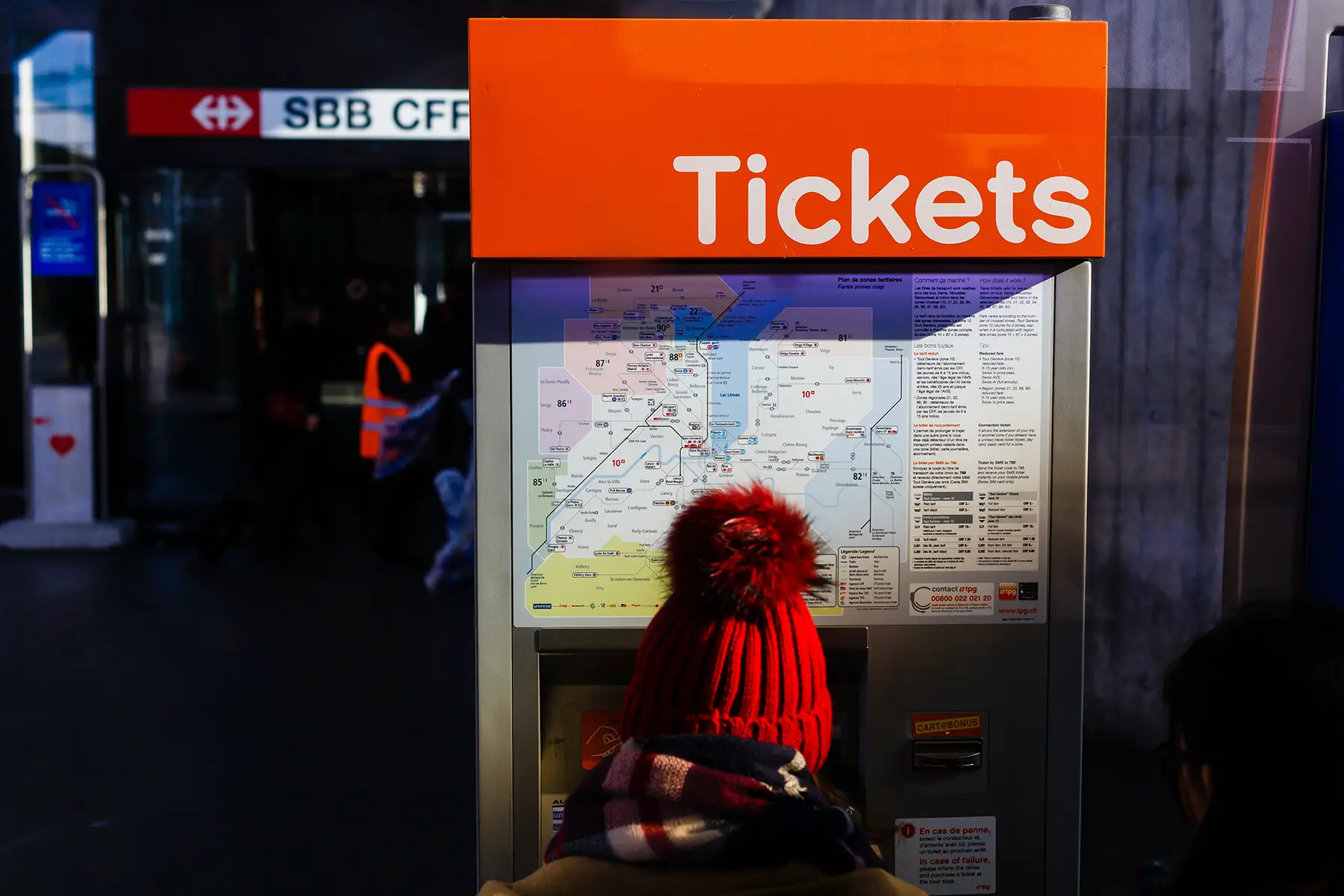
Other local public transportation providers in Switzerland also have their own apps, including:
- Zurich’s ZVV
- Basel’s BVB
- Basel’s BLT
- Bern’s BERNMOBIL
- Geneva’s TPG (available for Android and iOS)
- Lausanne’s TL (available for Android and iOS)
- Lucerne’s VBL
- Lugano’s TPL (available for Android and iOS)
Trains in Switzerland
Most of Switzerland’s trains are operated by Swiss Federal Railways. Being a multilingual country, the Swiss Federal Railways has a few different names depending on where you are:
- German: Schweizerische Bundesbahnen (SBB)
- French: Chemins de fer fédéraux suisse (CFF)
- Italian: Ferrovie Federali Svizzere (FFS)
- All of the above: it’s also common to see all three abbreviations (SBB CFF FFS)
As far as national stereotypes go, Switzerland’s reputation for punctuality and quality is deserved, including at the train station. According to the 2017 European Railway Performance Index, Switzerland is home to Europe’s safest, highest quality, and most intensely used rail network. While other European countries improved intercity travel times by investing heavily in high-speed lines, Switzerland put the focus on slower services by optimizing their timetables. Meticulous clock-face scheduling means that passengers can count on intercity services leaving at the top and bottom of the hour and regional connections by train or bus to coordinate with those, lowering wait times.
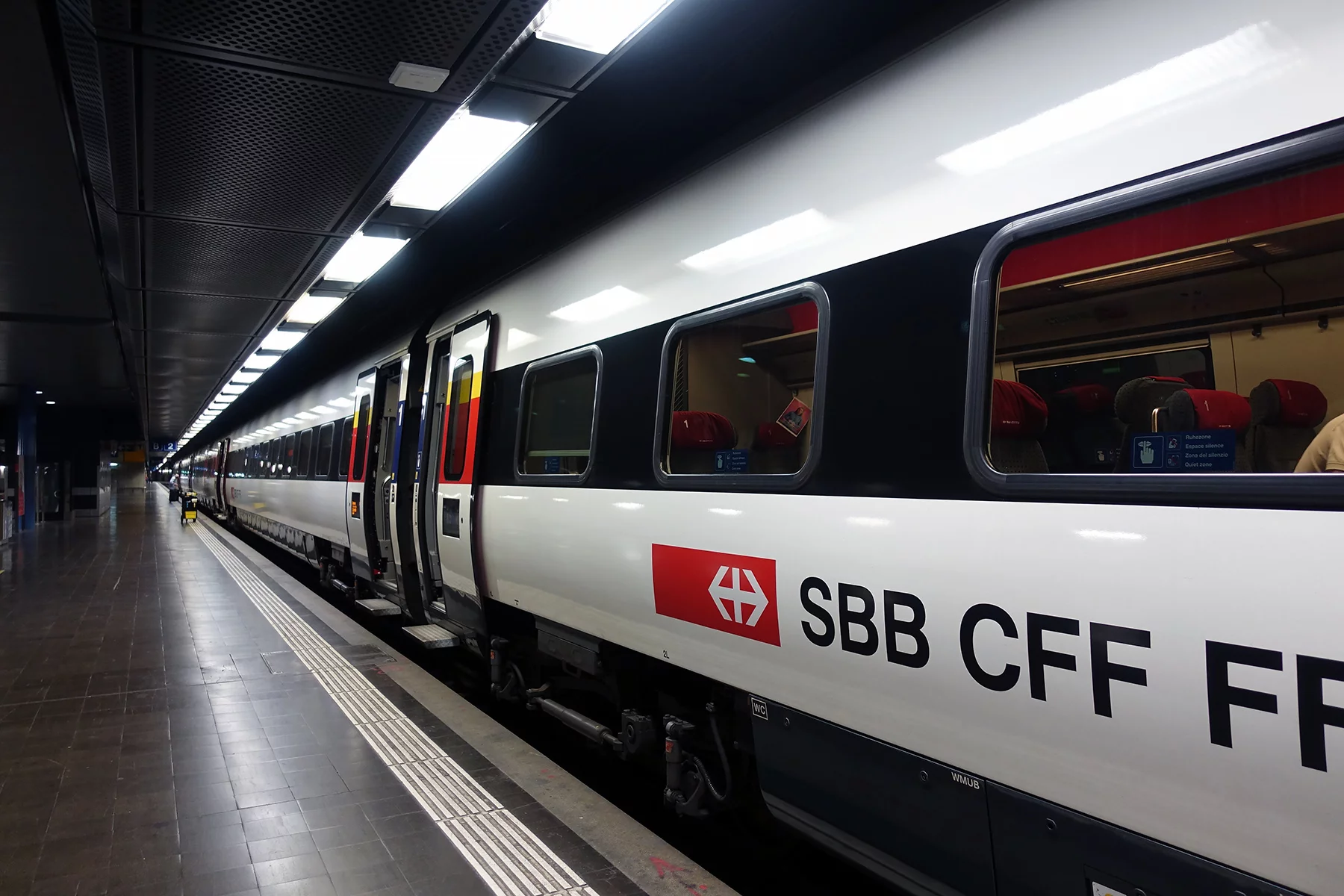
There are five classes of train service in Switzerland:
- InterCity (IC): long-distance services that connect major cities and hubs. IC trains have restaurant carriages and trolleys with drinks and snacks. Passenger carriages usually have two decks or sometimes the tilting, single-deck variety. Some cars also have quiet zones.
- InterRegio (IR): lines that connect a handful of adjacent cantons. IR trains don’t have restaurant carriages. Passengers cannot reserve seats on InterRegio trains.
- RegioExpress (RE): faster regional lines that don’t stop at all stations.
- S-Bahn (S): suburban lines that cover urban areas and their immediate surroundings. Switzerland has 12 S-Bahn networks.
- Regio (R): local trains that call at all stations along a route.
Train geeks, rejoice: SBB has all the information you need about Swiss trains, including beautiful photos to gawk at and routing information.
Train ticket costs in Switzerland
Prices for Swiss train tickets differ slightly in comparison to other European countries in one crucial way: the price you first see on the SBB website or app is actually only half of the price. The reason for this is that most regular commuters have a Half Fare Travelcard, which reduces all ticket prices by 50%. Although it seems a bit odd, it’s just an indication of how widespread the Half Fare Travelcard is. The card itself is CHF 185 per year (CHF 120 per year for those between ages 16 and 25). If the total amount of fares you pay is at least CHF 240 annually, the Half Fare Travelcard is a worthwhile investment.
You don’t need to book domestic train tickets in Switzerland in advance. Fares are fixed between any two cities and tickets are valid for any service that day. Tickets are available from ticket machines at the station, on the Swiss Federal Railways website, or through the SBB Mobile app.
If the eye-watering prices of Swiss trains are causing a bit of panic, worry not: just look for the discounts. SBB offers supersaver tickets, which offer discounts up to 70% (or even more if you use your Half Fare Travelcard). Keep in mind, though, that supersaver tickets are for a specific train at a specific time; if you miss the train, then you need to buy a full-fare ticket. Supersaver tickets are available up to 60 days before departure. SBB makes it easy to find the supersaver fares; just keep an eye out for the ‘%’ sign inside of a black triangle in the search results.
Urban and suburban trains in Switzerland
S-Bahn systems are urban/suburban railway networks that connect urban centers with their surrounding suburbs and commuter towns, similar to a metro network. Some S-Bahn networks in Switzerland (such as Zurich) are run by local public transportation authorities; others are run by Swiss Federal Railways.
Switzerland is home to 12 S-Bahn networks:
- Aargau (in German)
- Basel (in German and French)
- Bern (in German)
- Chur
- Fribourg/Freiburg
- Geneva
- Lucerne (in German)
- St. Gallen
- Ticino
- Vaud
- Zug
- Zurich
Lausanne is also home to Switzerland’s only metro network. In fact, Lausanne is the smallest city in the world with a metro network.
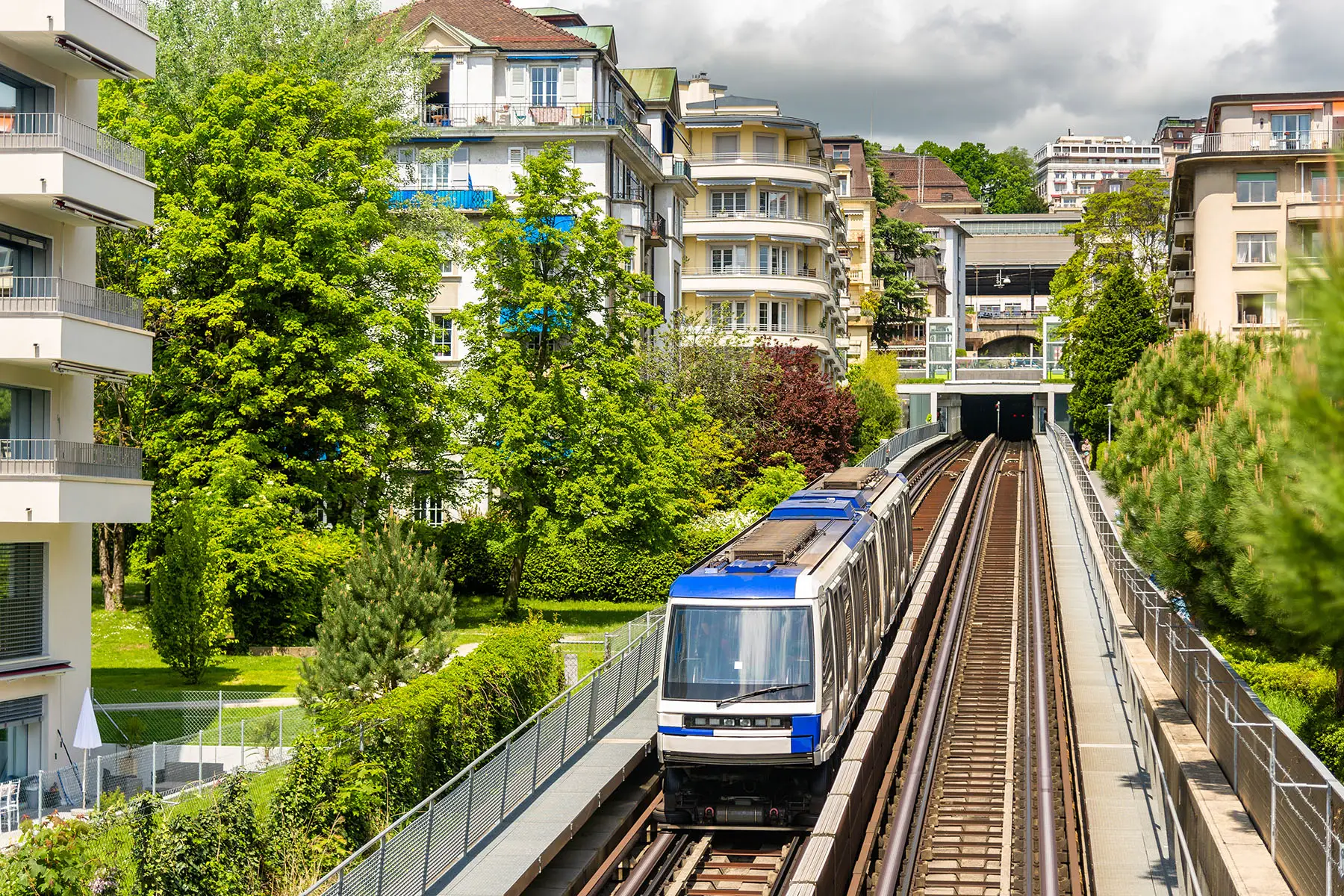
Three other transportation companies operate most of the rest of the regional trains in Switzerland:
- BLS AG: runs the S-Bahn networks for Bern and Lucerne, as well as some regional and RegioExpress
- Rhaetian Railway (Rhätische Bahn in German): runs most trains in the canton of Graubünden, including popular tourist routes like the Bernina Express and the Glacier Express.
- Matterhorn-Gotthard-Bahn: runs two services in the cantons of Graubünden, Uri, and Valais. The MGB routes are also popular among tourists.
Within Switzerland, eight cities use trams as part of their public transportation networks: Basel, Bern, Bex, Geneva, Lausanne, Neuchâtel, and Zurich. All Swiss tram networks are part of the local, municipally-run public transportation authorities.
International trains in Switzerland
Switzerland has international train connections to Austria, France, Germany, Italy, and Liechtenstein. Major routes include:
- Austria: RailJet trains from Vienna to Zurich.
- France: TGV Lyria high-speed trains from Paris to Basel, Geneva, or Zurich.
- Germany: ICE high-speed trains serve dozens of cities in both countries, connecting either through Zürich HB or Basel SBB.
- Italy: EuroCity trains from Milan and Venice to Bern, Geneva, or Zurich.
- Liechtenstein: Austrian-run ÖBB trains run a line connecting Buchs (St. Gallen) with Schaan-Vaduz, Forst Hilti, Nendeln, and Schaanwald.
- The Netherlands: some ICE high-speed trains connect Basel with Arnhem, Utrecht, and Amsterdam.
ÖBB Nightjet also uses night trains to directly connect Zurich with Berlin, Frankfurt, Graz, Hamburg, Linz, Vienna, and Zagreb.
For those traveling internationally, you’ll most likely connect through Basel SBB. Here, you can hop on a train to France, Germany, Italy, and even the Netherlands.
Swiss train timetables and maps
SBB offers timetables and network maps in plenty of formats. For instance, departure boards by station are available in PDF format, or you can create your own personal timetable for a specific route. Although there isn’t a single master timetable available for download, users can search for any journey on SBB’s online timetable.
Train stations in Switzerland
There are over 1,700 train stations in Switzerland, ranging from the 13-platform Zürich Hauptbahnhof (which handles 471,000 passengers on a typical weekday, the busiest in the country) to the spartan Punt Muragl Staz station (which handles just 50 passengers on weekdays). As part of Switzerland’s approach to making public transportation networks more efficient, train stations serve as hubs for all methods of transport. Buses and trams are timed in accordance with train schedules as a result.
Larger Swiss train stations have extensive services, including currency exchange, shopping, restaurants, banks, toilets, showers, luggage lockers, waiting rooms, free Wi-Fi, and bicycle parking. Smaller stations tend to have a more limited set of services available, though all of them at least have ticket machines.
Bus transportation in Switzerland
Switzerland is home to a number of authorities providing bus services. Bus routes fall into one of two categories: urban/suburban bus routes and regional/rural bus routes. In Switzerland, the former are generally run by a local municipal public transportation authority while the latter are run by PostBus, a subsidiary of Switzerland’s federal postal service.

There are dozens of local public transportation authorities in Switzerland. The systems serving the largest Swiss cities include the following:
- Basel: Baselland Transport (BLT) (in German) and Basler Verkehrs-Betriebe (BVB)
- Bern: BERNMOBIL
- Biel/Bienne: Verkehrsbetriebe Biel/Transports publics biennois (TB/TPB) (in German or French)
- Geneva: Transports publics genevois (TPG) (in French)
- Lausanne: Transports publics de la région lausannoise (TL)
- Lucerne: Verkehrsbetriebe Luzern (VBL) (in German)
- Lugano: Transporti Pubblici Luganesi (TPL)
- St. Gallen: Verkehrsbetriebe St. Gallen (VBSG) (in German)
- Winterthur: Stadtbus Winterthur (in German)
- Zurich: Zürcher Verkehrsverbund (ZVV)
Regional public transportation by bus in Switzerland is mostly run by PostBus. PostBus operates over 800 routes within dozens of route networks in almost every last corner of Switzerland, including remote mountainous areas. On winding mountain roads with blue-and-yellow postal horn signs, PostBus vehicles have right of way, all the while sounding its iconic three-tone Dreiklanghorn to warn oncoming drivers.
Ticket prices and fare zones differ across Switzerland. Most operators sell tickets at ticket machines or onboard the bus itself. Most bus companies also accept the SwissPass, which you can use if you have a valid subscription.
Bus timetables in Switzerland are available through the public transportation authority itself. In general, operators don’t provide fully downloadable timetables; rather, you can simply search for your itinerary through their website. For regional or rural routes, PostBus publishes its route networks online.
Taxis and ride-sharing services in Switzerland
Public transportation in Switzerland is made all the more popular because the alternatives are staggeringly expensive. As a matter of fact, Swiss taxis are the most expensive in Europe, with per-kilometer costs more than twice as high as in other major European cities. Hailing a taxi from the street is relatively easy, as cabs are plentiful. You can also hail a taxi with a ride-hailing app like go!, Talixo, or taxi.eu.
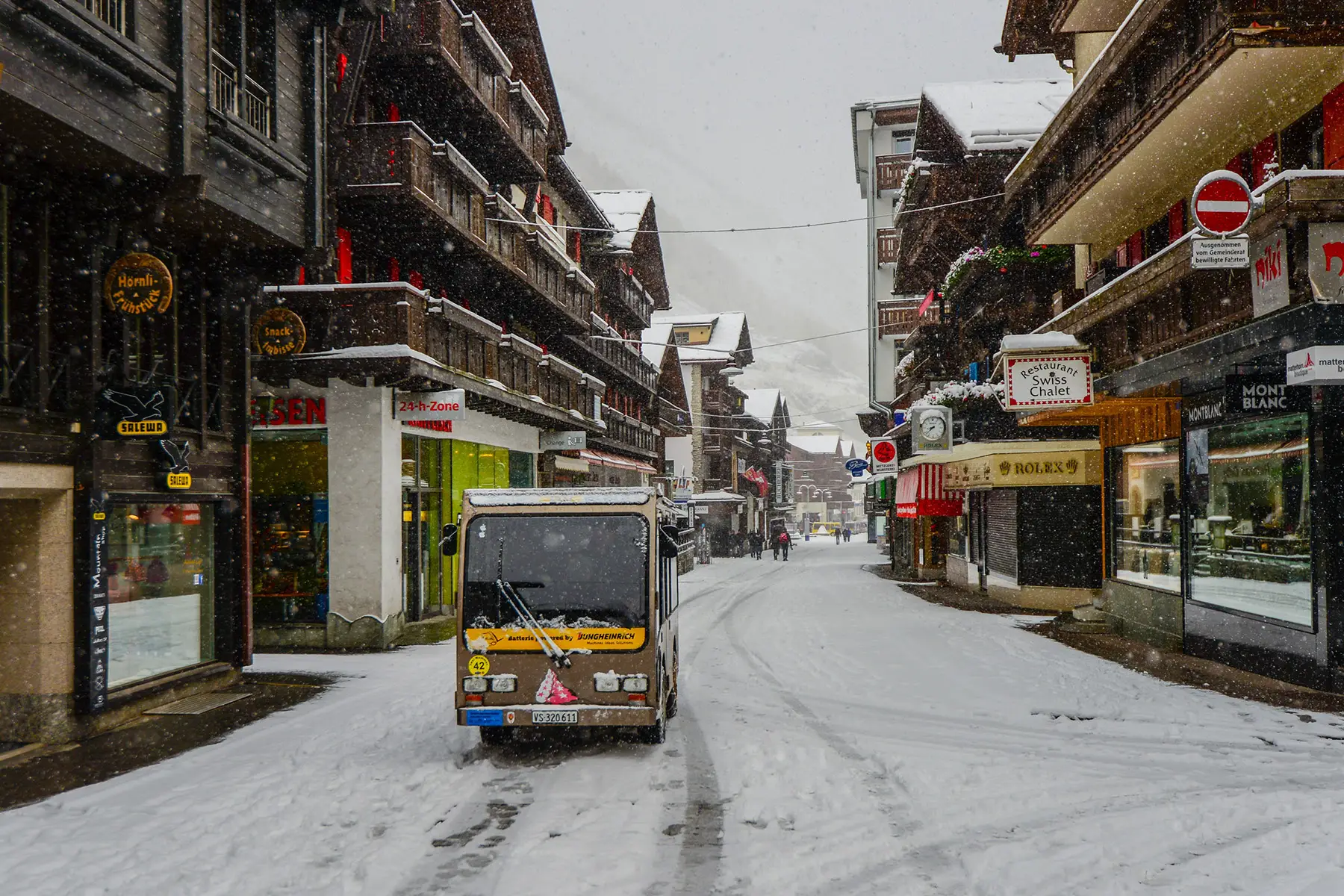
Taxi fares in Switzerland are not regulated across the country, so the cost differs from city to city. Zurich is, inarguably, the most expensive city in Switzerland to take a taxi: here, base fares are CHF 8 and each kilometer is an additional CHF 5. Other cities are not much better, with Bern and Geneva starting at CHF 6–7 and each additional kilometer adding CHF 3–4 to your bill. Taxis accept cash and credit cards, but it’s worth confirming payment methods before you get in the cab. Tips are not necessary.
If Swiss taxi fares are a bit rich for your budget, ride-sharing services are also available. Uber tends to offer lower fares and is available in several Swiss cities.
Long-distance coaches in Switzerland
As Switzerland is so well-connected by railway, long-distance coach travel within the country is not a widespread phenomenon. In addition, continental coach services may not offer routes entirely within its borders. However, there are a few international coach providers who offer travel to other European countries, such as FlixBus, RegioJet, and Eurobus. These companies have routes to Spain, Italy, Germany, Czechia, Austria, the Netherlands, Romania, and more. Traveling by coach usually takes longer than flying or going by rail, but it is often far cheaper.
These long-distance, cross-border services usually have free Wi-Fi, snacks and drinks, electricity outlets, toilets, and luggage space. You can usually buy and download your ticket via an app, and show it to the driver from your phone. You can usually catch your FlixBus from main stations in cities, but check when you book your ticket to avoid any last-minute surprises.
Airports in Switzerland
The Federal Office of Civil Aviation (FOCA) is the authority that oversees flight safety in Switzerland. The country is also a member of the European Union Aviation Safety Agency. The flag carrier for Switzerland is Swiss International Air Lines AG, but there are several other Swiss airlines including Chair Airlines, Edelweiss Air, and Helvetic Airways.
Although home to many airports, only a handful of Swiss airports have a significant amount of daily traffic. Despite Switzerland’s fairly small size, one domestic route remains popular: Zurich-Geneva. Swiss International Air Lines is the only carrier running the 50-minute flight, which is popular amongst business travelers and those connecting further afield. Direct trains run between both airports, taking just over three hours.
In 2020, Swiss civil aviation saw nearly 17 million passengers – a decrease of 71% from the year before. Around 85% of those passengers traveled to other European countries. The busiest airport is Zurich, followed by Geneva and EuroAirport Basel Mulhouse Freiburg.
Zurich Airport
Zurich Airport is Switzerland’s largest airport, situated about 13 kilometers north of the city center. In 2018 and 2019, around 31 million passengers passed through the airport – down to 8 million in 2020 and 10 million in 2021. It’s the hub for Swiss International Air Lines, and numerous international airlines offer flights to worldwide destinations.
The airport has parking that you can book in advance, but if you would rather take public transport to the airport, there are plenty of options. For example, the train and S-Bahn run to the city center, getting you there in just 10 minutes. For a more scenic route, you can take tram line 10.
Geneva Airport
Switzerland’s second-biggest airport, Geneva, is located about four kilometers outside the city center. Although it’s not as busy as Zurich, it runs direct flights to Europe, North America, North Africa, and the Middle East. In addition, you can catch a connecting flight to many other international destinations.
The airport has plenty of parking, including for electric vehicles. The airport is also well-connected by bus and train routes to Geneva, the wider canton, Switzerland, and even neighboring France.
EuroAirport Basel Mulhouse Freiburg
Although EuroAirport Basel Mulhouse Freiburg is located in France, it is shared between France, Germany, and Switzerland. It serves the Swiss city of Basel and is located 3.5km from the city – just a short distance from the border tripoint between France, Germany, and Switzerland. Destinations from this airport include European cities and North Africa.
Other methods of public transportation in Switzerland
Some cities in Switzerland also have small fleets of ferries working as public transportation. Zürichsee has a variety of lake and river cruises (some even have a restaurant and bar on them), all of which are accessible with a valid Zurich public transportation ticket. Over in Basel, Fähri-Verein has a small fleet of boats that crisscross the Rhine.
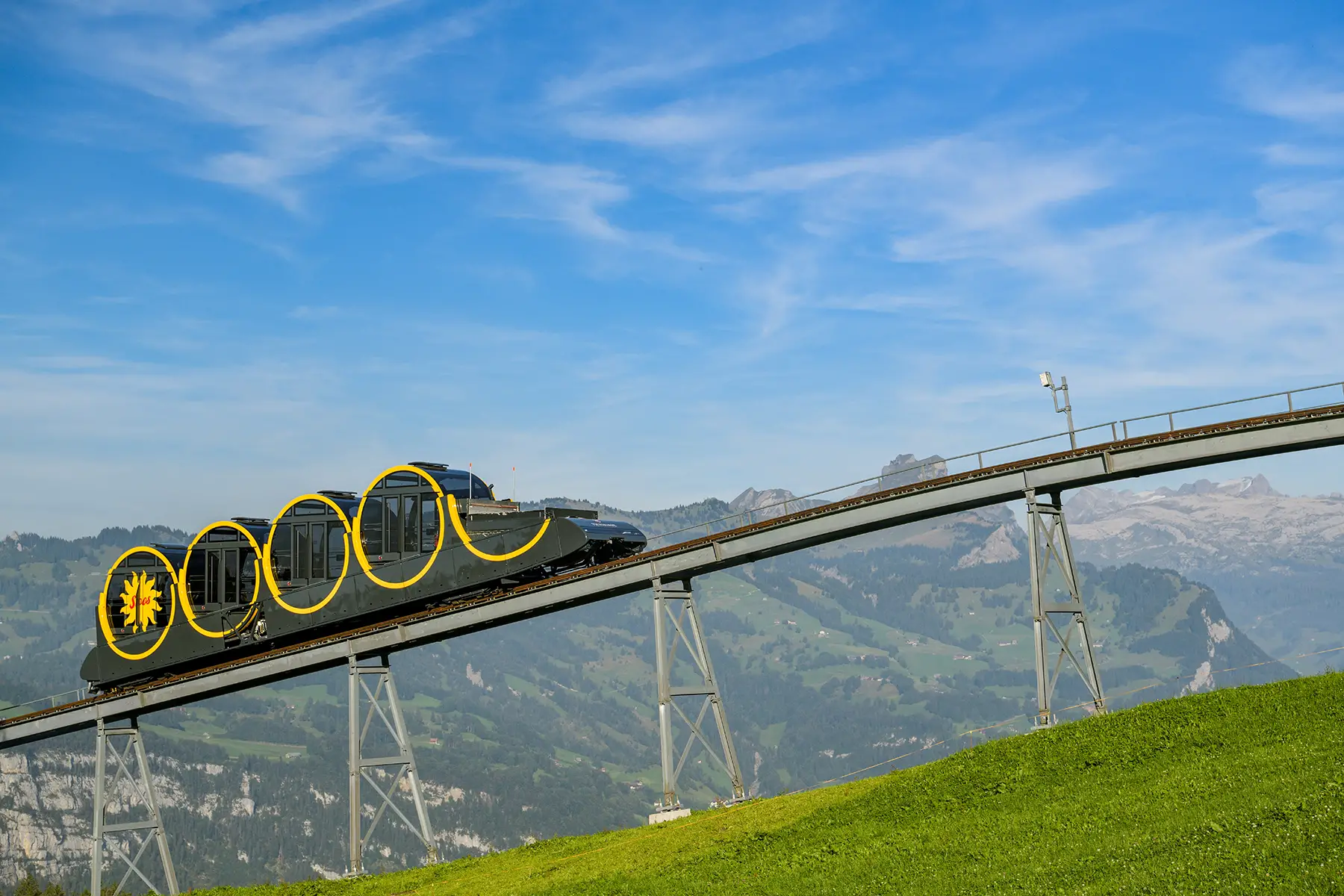
As an alpine country, Switzerland has no shortage of ways to scale a mountain. There are, in fact, dozens of funiculars in Switzerland. A few of the more notable funiculars are the Stoosbahn (the steepest funicular in Europe), the Niesen Funicular (whose service stairway is the world’s longest), and the St. Moritz–Corviglia Funicular (which connects St. Moritz with a ski area)
Public transportation subscriptions in Switzerland
Besides the SBB Half Fare Travelcard, there are plenty of ways to lessen the burden of ticket costs. SBB offers the following subscriptions:
- seven25 Travelcard: Travel free on SBB trains and public transportation networks between 19:00 and 5:00. Available to anyone younger than 25. CHF 39 per month or CHF 390 per year.
- Half Fare Travelcard: Probably the most popular public transportation subscription in Switzerland, the Half Fare Travelcard reduces all ticket costs by 50%. CHF 185 per year.
Almost all public transportation subscriptions in Switzerland go onto a SwissPass. The SwissPass is a wallet-size card that you load subscriptions or tickets onto, as well as use for things like bike rental, car-sharing schemes, or ski passes (of course). At least 250 transport authorities use the SwissPass, so you’re more likely than not to get one at some point.
If you don’t have a SwissPass yet, just go to a ticketing office for a public transportation provider. You’ll need an identity document as well as a recent passport-size photo.
The GA Travelcard
One public transportation subscription in Switzerland deserves special mention: the GA Travelcard. This subscription (whose name is short for Generalabonnement in German) allows unlimited travel on all SBB trains as well as other modes of public transportation in Switzerland. The GA Travelcard is available in a variety of categories with the billing period being either monthly or annual.
Second-class prices for the GA Travelcard are as follows:
- Adults: CHF 340 (month) / CHF 3,860 (year)
- Children (6–16): CHF 160 (month) / CHF 1,645 (year)
- Young adults (16–25) and students (25–30 and studying at a Swiss university or college): CHF 245 (month) / CHF 2,650 (year)
- 25-year olds: CHF 300 (month) / CHF 3,360 (year)
- Seniors (64+ [women] or 65+ [men]): CHF 260 (month) / CHF 2,880 (year)
- Disabled: CHF 225 (month) / CHF 2,480 (year)
- Dogs: CHF 805 (year)
GA Travelcard passes are expensive, but they’re worth your (or, potentially, your employer’s) money if you plan to take the train quite a bit. It’s also an eco-friendly alternative to driving in Switzerland.
How disability-accessible is public transportation in Switzerland?
Accessible transportation is enshrined in Swiss law. Officially, the law is the Federal Act on the Elimination of Discrimination against People with Disabilities, often shortened to the Disability Discrimination Act (DDA) or by its legal number (151.3).

Swiss Federal Railways has a comprehensive station accessibility map (make sure you zoom in to see more stations), including information on in-station support staff, available equipment, construction work schedules, contact information, and how the station complies with the DDA. The SBB aims to ensure all trains and 542 stations (and thus 86% of all passenger trips) meet DDA requirements by 2023. In reality, this means that an ever-increasing amount of Swiss train stations have step-free access from entering the station entrance all the way to boarding a train without the need for ramps or assistance. Trains in Switzerland all have wheelchair spaces as well as audiovisual passenger information; most have wheelchair-accessible toilets except for regional trains in the Seetal Valley.
Bus companies in Switzerland must also meet the requirements of the DDA to ensure accessible transportation for all. Swiss law requires all operators to roll out the necessary changes by 2023, although some cities fare better than others. Some commentators point towards Basel, Lucerne, Neuchâtel, and Zurich as good examples of cities changing bus stop heights and buying low-floor buses.
Beyond the rails, the SwissPass also has an accessibility feature. For instance, the SwissPass has a distinct groove in it, which helps those with a visual impairment identify the card more easily.
How environmentally friendly is public transportation in Switzerland?
Cities in Switzerland openly flaunt their sustainability records on the world stage, and it’s no wonder why. Sustainable approaches to living pervade all aspects of life, ranging from recycling in Switzerland to industrial-scale carbon-capture plants. As a result of the country’s all-hands-on-deck approach to reducing emissions and waste, Switzerland remains a country where taking the train is the logical choice.
Public transportation is one of the best ways for a society to approach sustainability, and Switzerland is no different in that regard. Swiss Federal Railways intends to use only renewable energy sources by 2025 and achieve climate neutrality by 2030. PostBus, Switzerland’s largest bus transportation company, is increasing the number of buses that run on batteries, fuel cells, or diesel hybrid engines. Cities like Zurich also impose tolls on cars and manage signal timings to make public transportation faster and to discourage vehicle use.
Fines and public transportation complaints in Switzerland
Fines for traveling without a valid ticket in Switzerland are standardized across travel modes and transportation companies. Passengers that dodge fares and receive a fine are also added to a national fare-dodger register (Schwarzfahrerregister in German; Registre national des resquilleurs in French).
The national fines for traveling without a ticket are:
- First offense: CHF 100
- Second offense: CHF 140
- Third offense: CHF 220
Traveling with the wrong ticket (such as one that only covers part of the journey) is also a fine-worthy offense in Switzerland. The fines for traveling with an incorrect ticket are:
- First offense: CHF 75
- Second offense: CHF 115
- Third offense: CHF 195
There are some circumstances where fines may be reduced or be rescinded altogether, such as if you forgot your personal travelcard. In this case, you only need to present your travelcard within 10 days and pay a processing fee (CHF 5).
More information on public transportation fines in Switzerland is available on Ticket Control. Passengers can either pay their fines or ask additional questions directly through Ticket Control, which PostBus manages on behalf of all transportation authorities in Switzerland.
Inquiries and complaints about other aspects of public transportation in Switzerland should be made directly to the provider. Customer service centers at SBB, PostBus, ZVV, and TPG regularly handle complaints in-person, through their website, or over the phone.
Useful resources
- BERNMOBIL – Bern’s public transportation operator
- FAIRTIQ – a public transportation ticketing app that covers most of Switzerland
- Stadtbus Winterthur – Winterthur’s public transportation operator
- Swiss Federal Railways – Switzerland’s national railway operator
- TB/TPB – Biel/Bienne’s public transportation operator
- TPG – Geneva’s public transportation operator
- TL – Lausanne’s public transportation operator
- TPL – Lugano’s public transportation operator
- VBL – Lucerne’s public transportation operator
- VBSG – St. Gallen’s public transportation operator
- ZVV – Zurich’s public transportation operator
